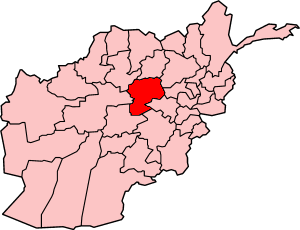Bamyan is one of the thirty-four provinces of Afghanistan. It is in the centre of the country. Its capital city is also called
Bamyan. Bamyan city is the largest city in the Hazarajat region of Afghanistan, and is the cultural capital of the Hazara ethnic group that predominates in the area.

In antiquity, central Afghanistan was strategically placed to thrive from the Silk Road caravans which criss-crossed the region trading between the Roman Empire, China and India.
Bamyan was a stopping off point for many travellers. It was here where elements of Greek, Persian and Buddhist art were combined into a unique classical style, known as Greco-Buddhist art.
Bamyan was the site of an early Buddhist monastery. Many statues of Buddha are carved into the sides of cliffs facing Bamyan city. The two most prominent of these statues were standing Buddhas, measuring 55 and 37 meters high respectively, that were the largest examples of standing Buddha carvings in the world. They were probably erected in the 4th or 5th century C.E. They were cultural landmarks for many years and are listed among UNESCO's World Heritage Sites. In March 2001 the Taliban government decreed that the statues were idolatrous and ordered them to be demolished with anti-aircraft artillery and explosives.
The lakes of Band-i-Amir lie at about two hours' drive west of Bamyan at an elevation of 9,800 ft/3,000 m. The lakes are astonishingly beautiful and their water is a deep blue, an extraordinary color tinted by the mineral salts from springs that feed them. The lakes are themselves craters of volcanoes, with 20-foot walls made of pumice stone.